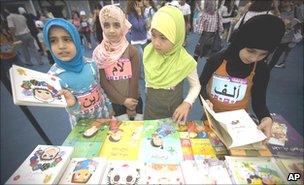Reading Arabic 'hard for brain'
- Published

Israeli scientists believe they have identified why Arabic is particularly hard to learn to read.
The University of Haifa team say people use both sides of their brain when they begin reading a language - but when learning Arabic this is wasting effort.
The detail of Arabic characters means students should use only the left side of their brain because that side is better at distinguishing detail.
The findings from nearly 40 people are reported in Neuropsychology.
When someone learns to read Arabic they have to work out which letters are which, and which ones go with which sounds.
It is the ability to tell letters apart that seems to work differently in Arabic - because telling the characters apart involves looking at very small details such as the placement of dots.
Professor Zohar Eviatar, who led the research team, said: "The particular characteristics of Arabic make it hard for the right hemisphere to be involved. When you are starting something new, there is a lot of [right hemisphere] involvement."
Clearer differences
The researchers looked at 37 university students. All of the students were native Arabic speakers and also spoke and read Hebrew and English.
In order to work out which side of the brain reads words, the researchers flashed words for less than a fifth of a second onto a screen - either just on the left or right, or different words on both sides.
When the eyes see something for just a short time, and it is at one side of a screen, only one brain hemisphere is quick enough to process the image.
The team measured how fast and how accurate the students were when they tried to tell words apart, separately in Arabic, in Hebrew and in English.
The students used both left and right hemispheres to tell Hebrew and English words apart.
Characters in English and Hebrew are easier to tell apart because there are clearer differences between them than there are in Arabic.
Sensitivity
When they looked at the students' reading of Arabic words it gave the team a clue about why children find the language difficult to learn to read.
These Arabic-speaking adults only used their left hemispheres to tell Arabic words apart.
When the Arabic readers saw simple words with their right hemispheres, they answered randomly - they could not tell them apart at all.
"The right hemisphere is more sensitive to the global aspects of what it's looking at, while the left hemisphere is more sensitive to the local features," says Professor Eviatar. And the very small differences between Arabic characters mean that reading these characters is difficult for the right hemisphere.
The team think this may give them some clues about what readers may be doing wrong when they begin to try to read Arabic.
Both young children and adults call on both hemispheres to help them learn a new task.
And using both hemispheres is the right thing to do when reading English or Hebrew - so children's learning strategies would be fine if they were reading another language.
But previous research has found that the right hemisphere is not that good at distinguishing small details, so readers starting to learn Arabic have to learn to focus on small details, which is not natural to them, but could help them shift to their left hemispheres.
Now the researchers want to compare very new and highly expert Arabic readers in the hope of finding out what their brains are doing when they look at letters and words.
Ultimately, they would like to work out how to teach Arabic reading better to children, including helping them to tell letters apart and how to remember which sound goes with which letter.
- Published24 June 2010
- Published9 February 2009
- Published24 August 2010
- Published7 February 2005
- Published20 July 2009
- Published24 June 2009